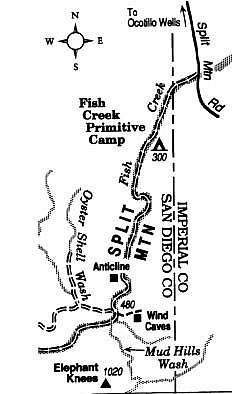 Facebook
Facebook
 X
X
 Instagram
Instagram
 TikTok
TikTok
 Youtube
Youtube
So crazy is the juxtaposition of rock formations at Anza-Borrego's Split Mountain that it makes your head spin. You can't help being amazed at the appearance of orderly sedimentary rock layers in one spot, curved and distorted sedimentary layers elsewhere, and great masses of broken, loosely cemented rock interleaving much of the area. Lucidity is emerging in a novel geologic paradigm proposed for the most chaotic-appearing spots: the concept of a sturzstrom, which is a massive (prehistoric, in this case), long-runout landslide.
Geographically, Split Mountain divides the rambling Vallecito Mountains on the west from the Fish Creek Mountains to the east. Over a million years or more, Fish Creek has maintained its course through this gap by cutting downward fast enough to compensate for the rise of the adjacent mountains. The canyon walls reveal layer-cake strata reflecting successive periods of invasion by the sea and reclamation by the land. Recent faulting has offset some of the layers, creating abrupt discontinuities.
Why is Fish Creek so named? This was once a sluggish stream with large potholes in its bed, some containing desert pupfish. A huge flood in 1916, it is surmised, smothered the creekbed with a thick carpet of sand and destroyed the habitat for the fish. Today's Fish Creek supports only scattered smoke trees, desert lavender, mesquite, and other shrubs. A trademark of the area is the Orcutt aster, a plant whose purple-petaled, yellow-centered, daisylike flowers bloom profusely after the rains come.
To reach Split Mountain from Highway 78 at Ocotillo Wells, turn south on Split Mountain Road and drive 7 miles to the unpaved road on the right. Anza-Borrego Desert State Park has rescinded its former daily use fees for remote areas such as these. It is possible to camp anywhere along the unpaved road ahead. How you proceed into Split Mountain depends on road conditions ahead (four-wheel-drive is recommended) or on your willingness to go on foot. Mountain-biking is another attractive option.
Beyond the Fish Creek primitive campground, which rests on a bluff to your left, the dramatically rising walls of Split Mountain continue for about two miles. Near the end of this narrow passage, take note of the famous anticline (inverted U) formation of sandstone layers on the west (right-side) wall. Its origin, asserts SDSU's Pat Abbott and others, was a sturzstrom of mammoth proportions occurring in the Fish Creek Mountains some 5 million years ago, with a runout of as much as seven miles. Presumably, one lobe of this fast-moving mass of broken debris dug itself into the floor of what was then a shallow sea and buckled the sediments.
Just beyond Split Mountain a side trail up the slope to the left leads to some "wind caves" in outcrops of sandstone. Farther south lies a maze of tributary washes and mud hills covering several square miles.


So crazy is the juxtaposition of rock formations at Anza-Borrego's Split Mountain that it makes your head spin. You can't help being amazed at the appearance of orderly sedimentary rock layers in one spot, curved and distorted sedimentary layers elsewhere, and great masses of broken, loosely cemented rock interleaving much of the area. Lucidity is emerging in a novel geologic paradigm proposed for the most chaotic-appearing spots: the concept of a sturzstrom, which is a massive (prehistoric, in this case), long-runout landslide.
Geographically, Split Mountain divides the rambling Vallecito Mountains on the west from the Fish Creek Mountains to the east. Over a million years or more, Fish Creek has maintained its course through this gap by cutting downward fast enough to compensate for the rise of the adjacent mountains. The canyon walls reveal layer-cake strata reflecting successive periods of invasion by the sea and reclamation by the land. Recent faulting has offset some of the layers, creating abrupt discontinuities.
Why is Fish Creek so named? This was once a sluggish stream with large potholes in its bed, some containing desert pupfish. A huge flood in 1916, it is surmised, smothered the creekbed with a thick carpet of sand and destroyed the habitat for the fish. Today's Fish Creek supports only scattered smoke trees, desert lavender, mesquite, and other shrubs. A trademark of the area is the Orcutt aster, a plant whose purple-petaled, yellow-centered, daisylike flowers bloom profusely after the rains come.
To reach Split Mountain from Highway 78 at Ocotillo Wells, turn south on Split Mountain Road and drive 7 miles to the unpaved road on the right. Anza-Borrego Desert State Park has rescinded its former daily use fees for remote areas such as these. It is possible to camp anywhere along the unpaved road ahead. How you proceed into Split Mountain depends on road conditions ahead (four-wheel-drive is recommended) or on your willingness to go on foot. Mountain-biking is another attractive option.
Beyond the Fish Creek primitive campground, which rests on a bluff to your left, the dramatically rising walls of Split Mountain continue for about two miles. Near the end of this narrow passage, take note of the famous anticline (inverted U) formation of sandstone layers on the west (right-side) wall. Its origin, asserts SDSU's Pat Abbott and others, was a sturzstrom of mammoth proportions occurring in the Fish Creek Mountains some 5 million years ago, with a runout of as much as seven miles. Presumably, one lobe of this fast-moving mass of broken debris dug itself into the floor of what was then a shallow sea and buckled the sediments.
Just beyond Split Mountain a side trail up the slope to the left leads to some "wind caves" in outcrops of sandstone. Farther south lies a maze of tributary washes and mud hills covering several square miles.
